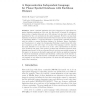Free Online Productivity Tools
i2Speak
i2Symbol
i2OCR
iTex2Img
iWeb2Print
iWeb2Shot
i2Type
iPdf2Split
iPdf2Merge
i2Bopomofo
i2Arabic
i2Style
i2Image
i2PDF
iLatex2Rtf
Sci2ools
DBPL
1999
Springer
1999
Springer
A Representation Independent Language for Planar Spatial Databases with Euclidean Distance
Linear constraint databases and query languages are appropriate for spatial database applications. Not only the data model is natural to represent a large portion of spatial data such as in GIS systems, but also there exist efficient algorithms for the core operations in the query languages. However, an important limitation of the linear constraint data model is that it cannot model constructs such as “Euclidean distance.” A previous attempt to expend linear constraint languages with the ability to express Euclidean distance, by Kuijpers, Kuper, Paredaens, and Vandeurzen is to adapt two fundamental Euclidean constructions with ruler and compass in a first order logic over points. The language, however, requires the input database to be encoded in an ad hoc LPC representation so that the logic operations can apply. This causes a problem that sometimes queries in their language may depend on the encoding and thus do not have any natural meaning. In this paper, we propose an alternat...
| Added | 04 Aug 2010 |
| Updated | 04 Aug 2010 |
| Type | Conference |
| Year | 1999 |
| Where | DBPL |
| Authors | Gabriel M. Kuper, Jianwen Su |
Comments (0)

